Keeping The Tradition Alive
- Jorge A. Zajia

- Aug 26
- 5 min read
"In the nineties the Chinese got into the game and changed everything forever, although to start with their models were quite crude it didn't take them long to up their game.
Keith and John had to change their business model quickly or disappear like so many of their rivals."
The above excerpt is a direct quote from the Scale Model Technical Services (SMTS) website. It refers to the boom of Made in China airplane models that took place during the 1990s. Coincidentally, I wrote an article about it not long ago, before ever reading the agreeing statement from SMTS. Yes, finding a supporting source gave me a warm and fuzzy feeling.
Recently, there has been a resurgence of what I have referred to as "home-made" airplane model manufacturers, but now I think "Western" is a more fitting label than "home-made." I say this because SMTS is not exactly a home-made operation, and while the title of this article has the word "tradition" in it, in this day and age, airplane model making is as much of a tradition, if not more, in China as it is in the UK, or elsewhere, for that matter.
So, who is SMTS? According to their website, they are a scale-model manufacturing company that was founded in 1983 in Hastings, United Kingdom. A town on the south coast of England, not too far from London.
SMTS not only manufactures airplane models. In fact, they seem to focus on automobiles. But according to Chris Sayers' The One True Scale (TOTS) Newsletter No. 10 (Dec. 2011), SMTS made many of the 1:200 airplane models that were sold for many years at Collectors Aircraft Models (CAM), near Heathrow airport. With the demise of CAM in 2011, SMTS started marketing their airplane models under the Sky Classics banner, many of which were exclusives for Aviation Retail Direct (ARD), the unofficial successor of CAM.
As one would expect, Sky Classics' output has been much smaller than that of the Chinese factories. So much so that I had never heard of them. Granted, I belong to a new generation of collectors, and I focus on 1:400 scale. Nonetheless, you would think I would have at least seen their name somewhere after 15 years of perusing through the different online stores and forums. That changed with a recent announcement from MTS Aviation Models.
MTS is an aviation collectibles shop located in Dayton, Ohio. MTS can be considered the successor of Jetstreams USA, a defunct shop from Columbus, Ohio, and the former U.S. distributor of many of the 1:200 models that were made in the UK before the Chinese boom, and one of the entities behind the creation of InFlight200.
So, in keeping with old traditions, a recent announcement from MTS included Sky Classics models. Just like the Jetstreams USA catalog used to include InFlightLE models, the UK hand-made line that preceded the Made in China InFlight200s of today. Quite the musical chair in the world of 1:200 scale airplane models.
Sky Classics could have easily continued to go unnoticed by me if it weren't for one particular model, a NASA Martin WB-57F Canberra.
Initially, I was only interested in the model itself, which I thought was a typical 1:72 military model. But after some digging, I found out that it actually was a 1:200 model, and, as quoted directly from MTS: "... casted, and hand finished in the United Kingdom... Sky Classics models are diecast models casted in white metal and made in very limited quantities. The models are made to be displayed on their landing gear and do not have rolling wheels."
I quickly translated all that to: Huh! These are old-school, but current-day, Made in the UK 1:200 models. It felt as if I had discovered that dinosaurs were alive today.
If you have read some of my recent blog posts or have come across some of my content on social media and the forums, you know I have been having a fixation of sorts with precision airplane models that are not made in China. I was under the impression that most of such models were a distant memory of a time when the UK was the Mecca for 1:200 scale precision airplane replicas, and that the resurgence of smaller airplane model manufacturers in the West, mainly making 3D printed models, was the modern-day version of that English tradition. But it was surprising to find out that there are still airplane models being mass-produced from scratch in the UK today.
This model caught my attention because NASA's WB-57s are one of the major local attractions for Houston's aviation enthusiasts. I happened to have learned to fly at Ellington Field, where NASA's WB-57Fs are based. So, by purchasing this model, not only was I adding to my collection a replica of a relevant aircraft in my life, but also one of those peculiar Made in the UK models that I have been so interested in as of late.
Let's check the model out:
The model comes in a typical "artisanal" style plain box, common among such models. No outer sleeve with fancy artwork, just a simple sticker, but it is more than enough.


Once the box is opened, the cushioning material is not the typical foam, but rather the less common expanded polystyrene (EPS), similar to the only Small World Super Constellation that I have in my collection. That Small World Connie arrived looking as if it were covered in snow, which makes me doubt the suitability of EPS as a cushioning material for metal models.

I am not going to pretend to be a WB-57F expert, but putting my opinion in simple terms, I would say the mold resembles the aircraft quite well.
It is a one-piece mold, so there's no need to worry about loose wings and such. There is a discrete supporting leg on the underside to prevent it from sitting on its tail, a clever addition.


The model is decaled. The decals are fine, but there's room for improvement in this area. But, hey, if you want a NASA WB-57 made out of metal in 1:200 scale, this is it, and I'm okay with that.
Below are some photos of the WB-57 operations I got to enjoy during my time as a Flight Instructor at Ellington Field. Unfortunately, I never caught one with the NASA titles on the tail.
The model sits nicely on my 1:200 shelf.
Even though it has been referred to as The One True Scale, the fact of the matter is that 1:200 is probably never going to become more popular than 1:400 in the same way that the latter has largely displaced 1:500. 1:200 is just not nearly as practical. Having said that, small to mid-size aircraft display wonderfully on the larger scale.































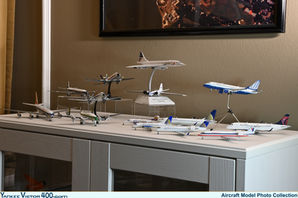
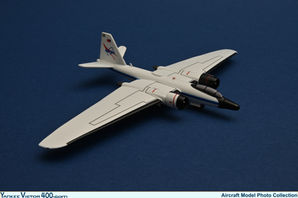


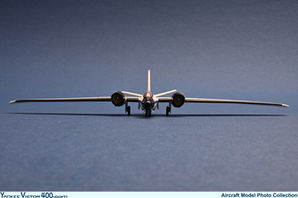




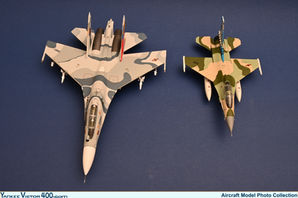
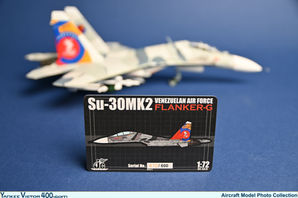
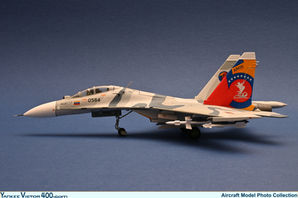










Comments